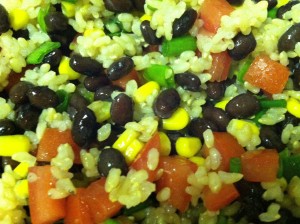 Protein is probably one of the hottest topics nowadays when referring to nutrition, fitness and overall health so needless to say it is a subject I care deeply about! And for good reason…
Protein is probably one of the hottest topics nowadays when referring to nutrition, fitness and overall health so needless to say it is a subject I care deeply about! And for good reason…
Protein provides us with the building blocks for healthy muscles, organs and immune system. When we consume it, our body breaks it down into individual amino acids (the building blocks) which is what in turn nourishes it. There are 9 essential amino acids (EFAs) that need to be present in a food source for it to be deemed a complete protein: Histidine, Isoleucine, Leucine, Lysine, Methionine, Phenylalanine, Threonine, Tryptophan and Valine. Only some individual food sources fill those requirements. In other cases, you must combine foods to obtain proper EFA amounts.
What does that mean?? Well.. when discussing protein, nutritionists often speak in terms of “complete” and “incomplete” proteins. Complete protein foods contain all of these EFAs and in appropriate amounts of each for supporting biological functions in the human body – while foods that contain only some or not enough of each EFA are said to be incomplete.
Eggs, fish, meat, poultry and dairy products are considered to be complete proteins. Apart from some exceptions, vegetable sources tend to be missing or do not have enough of one or more EFA. For this reason vegetarians, and especially vegans, are often not absorbing enough quality protein in their diets. However, there are complete vegetarian protein sources.
vegetarian complete protein foods:
• Quinoa (so simple and versatile- can easily be a substitute for rice in most dishes)
• Amarenth
• Buckwheat
• Spirulina
• Hemp seeds
• Chia seeds
• Soybean products**
** Avoid or limit unfermented forms of soy such as tofu and edamame as they contain “anti-nutrients”, which literally block the absorption of the nutrients of soy (yes, including the PROTEIN). Unfermented soy is also high in goitrogens- substances that suppress our thyroid function. Instead, choose fermented soy such as tempeh and miso. The process of fermentation destroys these dangerous compounds allowing us to take in the health benefits of soy. Also keep in mind, soy crops are some of the most highly sprayed (with pesticides) and genetically modified crops, so make sure to choose organic whenever possible!
vegetarian protein combining:
You may be asking – Can I still get enough protein if I do not eat the above foods very often or at all!? After all, that was a pretty short list- why would you want to rely on only these sources? Well good news veggie lovers..one can easily obtain all of the required EFA’s by eating a variety of beans, grains, nuts, seeds, and vegetables together. This is a process called protein combining.
Grains, legumes, nuts, and many vegetables are actually some of the most nutritionally dense foods as they are all rich in complex carbohydrates and fibre – 2 things animal proteins lack. They are also excellent sources of protein but the difference is they are each low in certain EFAs, preventing them from being complete. For example, the limiting amino acid in grains is usually lysine; in legumes it can be methionine and tryptophan. So by combining the two, the low level of lysine in grains is complemented by a higher level in legumes, and vice versa, to make our ‘complete protein’. If you find this all a little complicated, I have even better news- It is not necessary to combine specific vegetarian protein foods in one sitting to make a complete protein. Yay!! So just make sure you are getting a combination of these foods in your diet throughout the day.
veg combinations that make a complete protein:
- Legumes + seeds
- Legumes + nuts
- Legumes + grains
snacks/meals containing complete veg protein
- Beans on whole wheat toast
- Hummus and pita bread
- Nut butter on whole grain bread
- Whole grain rice and beans, peas, or lentils
- Split pea or lentil soup with whole grain bread or seeded crackers
- Whole wheat tortilla with refried beans
- Trail mix (eg: almonds & sunflower seeds)
- Rice cakes with natural nut butter
- Tofu-vegetable stir-fry over whole wheat rice or pasta
- Spinach salad with edemame beans and sliced almonds
- Vegetarian chilli with a whole wheat bun
- Kale salad with chickpeas and rice
As you can see the combinations are endless! So have fun mixing and matching. Check out my *recipe below for a great filling black bean and rice salad – perfect for supplying all your protein requirements, and it’s also high in antioxidants and fibre!
how much protein should one consume in a day:
How much protein you should get per day depends on several factors – age and activity level being the most significant factors. In general I encourage the average healthy, moderately active person to get around 0.5 – 0.6 grams of protein per pound of body weight. So for a 150 lb individual this would equal to 75-90 grams/day. A highly active person, male or female, should definitely aim for the higher end of the spectrum. The same can be said for the elderly, as a high protein diet can help prevent osteoporosis and sarcopenia (reduction in muscle mass), both significant problems in the elderly. Yes this may seem like a lot but if you plan ahead and spread your intake throughout the day (your body can only really absorb around 30g of protein at one time) you can certainly reach that amount.
I can’t stress enough how important consuming adequate quality protein, coming from whole foods, helps build and maintain healthy bones, muscles, skin and organs. In short, so many body functions rely on protein, not to mention it helps keep you full and your energy levels up throughout the day.
*Recipe: Protein Packed Black Bean and Rice Salad
 Ingredients
Ingredients
- 1/2 cup olive oil
- 1/4 cup apple cider vinegar
- 2 tbsp fresh lemon juice
- 1 tablespoon Dijon mustard
- 1 teaspoon ground cumin
- 1 teaspoon minced garlic
- 2 1/2 cups cooked long-grain white rice (about 1 cup raw), cooled
- 1 (19 oz/540 mL) can black beans, well rinsed, drained
- 3/4 cup chopped red bell pepper
- 1 cup corn kernels- fresh if possible. (or frozen, thawed if must)
- 1 cup edemame beans (fresh or frozen & thawed)
- 1/2 cup chopped green onions
- ¼ cup chopped fresh cilantro (or parsley if you dislike cilantro)
Preparation
- Whisk oil, vinegar, lemon juice, mustard, cumin and garlic in medium bowl until well blended.
- Combine rice, beans, peppers, corn, edemame, onion and herbs in a large bowl.
- Toss salad with enough dressing to moisten.
- Season with salt and pepper to taste.
- If made ahead, cover and refrigerate. Makes approx 6 Servings
Finally, if there is one main point I can leave you with, it is to as often as possible make conscious snack and meal decisions in order for them to be as nutritionally “powerful” as possible – hence whole foods high in fiber, protein, and complex carbs. Ditch the packaged stuff!
Happy eating!
Justine


